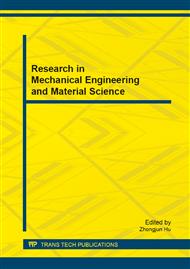p.330
p.334
p.338
p.345
p.349
p.354
p.358
p.363
p.369
Comparative Study on the Wear Behavior of FPM and NBR in the Natural Crude Oil Medium
Abstract:
The wear behavior of stator rubber in the natural medium of crude oil in oil-drilling screw pumps directly matters to its service life and sealing property. The premature failure of stator rubber is the main cause for the shortening life of screw pumps. In order to study the wear mechanism of NBR and FPM, a friction wear test was conducted at room temperature by using a MPV-600 micro-computer-controlling grain-abrasion testing machine, in which NBR, FPM and 45# steal pair are the testing subjects. SEM was afterwards employed to observe the surface topography before and after the rubber wear. The test result shows that at the constant low load, the wear extent of FPM increases in a stable, linear way when the rotor rotating speed increases, and the wear extent of NBR increases with the increasing speed of the rotor rotating speed. However, when the rotating speed is over 400r/min, the wear extent of NBR decreases instead. This might be attributed to the improvement of the local lubrication state on the friction surface. Much consistence is indicated in the changing rule of the friction coefficient of the two types of rubber and the changing wear extent with the rotating speed. At the constant, low rotating speed, the wear extent of NBR and FPM basically increases linearly, while the friction coefficient of NBR, FPM and steel pair decreases with the increasing load.
Info:
Periodical:
Pages:
349-353
Citation:
Online since:
October 2013
Authors:
Price:
Сopyright:
© 2014 Trans Tech Publications Ltd. All Rights Reserved
Share:
Citation:


